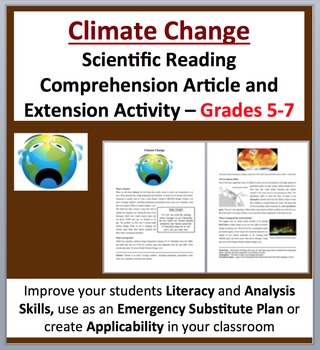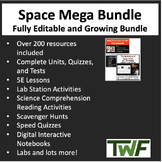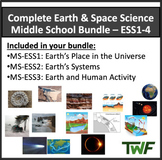- Zip
- Google Apps™

Also included in
- Everything you need to teach climate change in one place. This bundle includes engaging lessons, fun activities, and assessments that really check for your students' understanding.Your Bundle IncludesHigh School Lesson, Assessment, and WorksheetsMiddle School Lesson7 Case StudiesBell Ringer, Class WPrice $26.97Original Price $76.67Save $49.70
- Space Grade 5-7 Science Reading Article Bundle. This resource contains 9 reading comprehension articles for Grades 5-7 (ages 10-12) students as well as older kids with lower developed learning levels. Tackle literacy and science by having your students read and answer questions from a scientific artPrice $8.97Original Price $25.62Save $16.65
- Everything you need to teach space science to grades 6-10 in one place. This bundle includes engaging lessons, fun activities, and assessments that really check for your students' understanding.Your Bundle IncludesIndividual Lessons, Assessments, and WorksheetsCase StudiesBell Ringer, Class Warm-Up,Price $97.97Original Price $267.15Save $169.18
- This completed bundle contains 35 reading comprehension (disciplinary literacy) articles. If you purchase this bundle, you'll only pay $1.00 per article. These articles are geared towards students in grades 5-7 (age 10-12) or older kids with learning or language difficulties. This reading is perfectPrice $34.97Original Price $132.37Save $97.40
- This completed bundle contains 35 reading comprehension (disciplinary literacy) articles. If you purchase this bundle, you'll only pay $1.00 per article. These articles are geared towards students in grades 5-7 (age 10-12) or older kids with learning or language difficulties. This reading is perfectPrice $34.97Original Price $131.31Save $96.34
- This resource contains 100+ reading comprehension articles for students in grades 5-7 as well as older students with lower developed learning levels. Tackle literacy and science by having your students read and answer questions from a scientific article. Each page highlights and explains key terms fPrice $97.22Original Price $388.66Save $291.44
- Natural Disasters and Weather - Scientific Reading Comprehension Articles - This resource contains 12 reading comprehension articles for Grades 5-7 (ages 10-12) students as well as older kids with lower developed learning levels. The readings inside this bundle focus on physics applications that mosPrice $16.97Original Price $39.70Save $22.73
- Each resource inside this bundle was handpicked to cover all aspects of the MS-ESS2 curriculum (ESS3-1, ESS3-2, ESS3-3, ESS3-4, ESS3-5). The resources found inside will ensure your students fulfill each requirement of the standard and keep them interested and engaged throughout. Your purchase also iPrice $37.97Original Price $135.85Save $97.88
- This Middle School Earth and Space Science Complete Bundle includes all the resources you need to teach Middle School Earth and Space science according to the NGSS. Your Bundle IncludesMS-ESS1: Earth’s Place in the UniverseMS-ESS2: Earth’s SystemsMS-ESS3: Earth and Human ActivityYour purchase also iPrice $78.97Original Price $258.26Save $179.29
Description
Climate Change - This fully editable Science Comprehension Reading Activity for Grades 5-7 (ages 10-12) is perfect for distance learning, substitute plans, an activity to supplement your lesson, or for scientific literacy practice. Each page highlights and explains key terms for student reference. Questions include knowledge (direct from the paper), thinking, connecting, and open-ended varieties.
The Reading Looks at:
- What is Climate?
- What’s the big deal?
- The Greenhouse Effect
- What’s causing all this carbon dioxide?
- Why are we so concerned about 1.4◦F?
- What can we do?
Buyer Comment: Used this resource as an activity for my early-finishers. It was perfect! It gave them something to do after finishing early, but wasn't too extremely challenging. Many students expressed that the reading was actually quite interesting as well!"
Google Classroom and Distance Learning Ready
- This resource is perfect for in-class or distance learning and integrates seamlessly with Google Classroom.
- Automatically creates a copy of the reading and puts it directly into your Google Drive with a single click.
- Purchase --> Open --> Click --> Assign to your students
- The reading also includes a Microsoft Word and PDF version.
Having all three options allow you to assign the reading to your students without worrying about formatting issues as all the work has already been done for you. It also allows you, as well as your students, to access everything no matter where you are or what kind of equipment is being used.
--------------------------------------------------
This resource will take your students between 40-60 minutes to complete and includes a variety of questions. An answer key is also included for your reference.
---------------------------------------------------
The Problems You Face
- Not having the time to properly teach scientific literacy (disciplinary literacy) or improve your students reading comprehension and analysis skills.
- Some students work faster than others and you would like an interesting extension activity for your faster-moving students to keep them learning and engaged.
The Solution
This fully editable, NO PREP reading comprehension article is composed of relevant, applicable, and engaging reading activities which can be used to:
• introduce your topic
• improve your students literacy skills
• improve your students reading comprehension and scientific literacy skills
• improve your students' analysis skills
• provide an extension activity to students who move at a faster pace
• provide extra credit to students in need
• measure your students literacy skills
Furthermore, this resource works very well as an emergency substitute plan as it will keep your students on task and focused while you are away.
This resource will take your students between 30-60 minutes to complete and includes a variety of questions. An answer key is also included for your reference.
----------------------------------------------------------------------------------------------
Health and Wellbeing
• Immune System – Your Body’s Police Force
• How Protective Equipment Keeps You Safe
• Caffeine: The Elixir of Energy
• Exercise and its Importance for Health
• Effects of stress on the brain
• Diabetes
Ecology
• Why Leaves Change Color In The Fall
• The Seasons and What Causes Them
• Oil Spills and Their Consequences
• Farming – Is Organic Really Better?
• Bioaccumulation and Biomagnification
• Mosquitoes And The Diseases They Spread
Chemistry
Physics
• Hydroelectric Energy Production
• Solar Electricity Production
• Fossil Fuel Energy Production
• Nuclear Energy - Fission and Fusion
• The Science of Roller Coasters
• The Northern and Southern Lights
Natural Disasters and Weather
• Natural Disasters: Weather and Climate
• Natural Disasters: Earth, Water, and Space
General Sciences
• Making Food Using Fermentation
• The Limitations of Space Travel
• The Planets Of Our Solar System
• Fossils
Biology
• Genetically Modified Organisms
• Twins - Identical and Fraternal
**The Best Deal** If you really want to save some money, please consider my Science Reading Comprehension MEGA Bundle - Grades 5-7. You will save 67% vs. purchasing each resource individually.
----------------------------------------------------------------------------------------------
Praise For My Other Reading Comprehension Resources:
"I teach middle school science and need to include informational text in my classroom. These readings are great for independent reading for my grade level and upper-level readers. The articles address CCSS.ELA-Literacy.RST.6-8.1 (Citing specific textual evidence to support analysis of science and technical texts.) and CCSS.ELA-Literacy.RST.6-8.10 (By the end of grade 8, read and comprehend science/technical texts in the grades 6-8 text complexity band independently and proficiently.). The leveled questions allow you to subtly assign the questions to different ability students working in a group.
Topics are relevant to the students and current. Graphics draw the students into the article. I'm going to have one printed and waiting in for my substitute folder too!
THANKS!"
"Thanks for putting together a wonderful resource."
"I teach Special Education high school science in Maryland in a special school for children with learning disabilities/Autism. I liked the readings and I think students could relate to the topics. I know these are too high a reading level for most of my students and I would read it out loud and highlight the important information together. I would not be able to use the higher-order thinking questions (which I like) with these kids. For my high students (very few of these in my school :), I really like these especially how you noted where you got the information which if they were inclined, they could go back to the original source. I like that you have scaffolded the questions and I would only be able to use these with a handful of students, but I think in a regular high school classroom (I spent many years in regular ed) these are spot on. Thank you for sharing."
----------------------------------------------------------------------------------------------
Each summary is rich with age-appropriate content (grades 5-7) and is 1-3 pages long (13-font). Following each are 5-8 questions along with the answer key, which will help guide your students understanding. The questions include information-based questions straight from the article as well as more open-ended thinking questions that provide an extension for the learning.
How this product will help your students:
- Improve their scientific and disciplinary literacy skills
- Improve their reading comprehension and scientific knowledge
- Give them insights into important scientific concepts
- Provide an extension activity for your faster moving/more gifted students
How this product will help you:
- Allow you to meet the NGSS, TEKS and Common Core Standards
- Provide you with a concise introduction to your topic
- Provide you with an engaging and easy to leave substitute plan which will keep your students engaged and on task
- Provide you a means of measuring your students' literacy skills
We don't spend enough time teaching scientific literacy to our students. This is either because we don't have the resources to do so effectively or we don't have the time. However, teaching our students to become scientifically literate is vital if we want them to succeed in life. We need them to know about the world they live in and about the issues they face.
I also have a range of assignments and lessons/units from other grade levels at my store. Please CLICK HERE to have a look around and don’t forget to follow if you like what you see.
Also, please visit my blog Teach Science With Fergy for my thoughts on teaching, learning, and everything in between.














